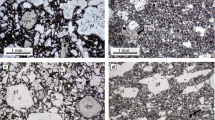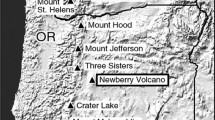Abstract
We have conducted high pressure (to 3 kbar), water saturated melting experiments on an andesite (62 wt% SiO2) and a basaltic andesite (55 wt% SiO2) from western Mexico. A close comparison between the experimental phase assemblages and their compositions, and the phenocryst assemblages of the lavas, is found in water saturated liquids, suggesting that the CO2 content was minimal in the fluid phase. Thus the historic lavas from Volcan Colima (with phenocrysts of orthopyroxene, augite, plagioclase, and hornblende) were stored at a temperature between 950–975 °C, at a pressure between 700–1500 bars, and with a water content of 3.0–5.0 wt%. A hornblende andesite (spessartite) from Mascota, of nearly identical composition but with only amphibole phenocrysts, had a similar temperature but equilibrated at a minimum of 2000 bars pressure with a dissolved water content of at least 5.5 wt% in the liquid. Experiments on the basaltic andesite show that the most common natural phenocryst assemblages (olivine, ±augite, ±plagioclase) could have precipitated at temperatures from 1000–1150 °C, in liquids with a wide range of dissolved water content (∼2.0–6.0 wt%) and a corresponding pressure range. A lava of the same bulk composition with phenocrysts of hornblende, olivine, plagioclase, and augite is restricted to temperatures below 1000 °C and pressures below 2500 bars, corresponding to <5.5 wt% water in the residual liquid. Although there is some evidence for mixing in the andesites (sporadic olivine phenocrysts), the broad theme of the history of both lava types is that the phenocryst assemblages for both the andesitic magmas and basaltic andesitic magmas are generated from degassing and reequilibration on ascent of initially hydrous parents containing greater than 6 wt% water. Indeed andesitic magmas could be related to a basaltic andesite parent by hornblende-plagioclase fractionation under the same hydrous conditions.
Similar content being viewed by others
Author information
Authors and Affiliations
Additional information
Received: 10 December 1996 / Accepted: 21 August 1997
Rights and permissions
About this article
Cite this article
Moore, G., Carmichael, I. The hydrous phase equilibria (to 3 kbar) of an andesite and basaltic andesite from western Mexico: constraints on water content and conditions of phenocryst growth. Contrib Mineral Petrol 130, 304–319 (1998). https://doi.org/10.1007/s004100050367
Issue Date:
DOI: https://doi.org/10.1007/s004100050367




